Sweetgum Trees (Gumball Tree): Types, Leaves – Liquidambar Identification Guide (With Pictures)

Sweetgum trees (botanical name Liquidambar) are a species of large deciduous flowering trees with large lobed leaves, small globular flowers, and seed-containing spiky gumballs. Sweetgum trees are identified by their colorful lobed leaves that can be orange, red, yellow, or purple colors in the fall. The characteristic feature of many sweetgum varieties is their spiky balls measuring up to 2” (5 cm) across.
The most popular sweetgum tree is the American sweetgum (Liquidambar styraciflua) which is also called gumball tree. The American sweetgum is a tall ornamental tree with its colorful fall leaves and rounded pyramidal crown. It is a beautiful shade or lawn landscaping tree. Other common trees in the Liquidambar genus include the Sweetgum ‘Slender Silhouette’ (Liquidambar styraciflua ‘Slender Silhouette’) and Fruitless Sweetgum (Liquidambar styraciflua ‘Rotundiloba’).
This article is a guide to identifying sweetgums trees. Descriptions and pictures of popular sweetgum trees will help identify these deciduous landscape trees.
Sweetgum Tree Facts
There are 15 species of sweetgum trees in the genus Liquidambar and the family Altingiaceae. Sweetgums are ornamental deciduous trees that are native to North America, Asia, and the Mediterranean. Sweetgum trees are relatively fast-growing trees that reach a mature height between 32 and 130 ft. (10 – 40 m).
Sweetgum trees get their name from the sweet, sticky, resinous substance the oozes from the cut trunk. The scientific name—Liquidambar—also refers to this yellow sap and means liquid amber. The common name redgum comes from the spectacular red color of the leaves in the fall and the reddish-yellow color of the tree’s sap. Other common names for the sweetgum tree include liquid amber tree and sugar gum tree.
The spiky balls or gumballs on the sweetgum tree help to identify this genus. The sweetgum tree ball looks similar to sycamore tree fruit. For some gardeners, the spiked gumballs can be a nuisance in the fall. The hard, woody balls can roll if you stand on them, causing injury if you fall. Additionally, children can get injured by sharp spikes.
Sweetgum trees grow in full sun and well-draining moist soil. However, hardy sweetgum trees are also tolerant of drought and can grow well in wet ground. You can find sweetgums growing in eastern North America from Connecticut to Florida and as far west as Texas, Missouri, and Oklahoma.
Sweetgum Leaves
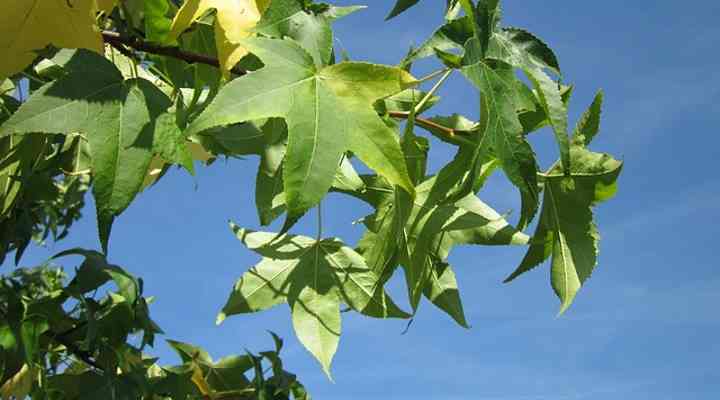
Sweetgum leaves is summer
Sweetgum tree leaves are star-shaped, large palmate leaves with three to seven lobes. The large leaves from sweetgum trees grow between 5” and 8” (12 – 20 cm) long. Looking at pictures of sweetgum leaves, you’ll see that each leaf consists of three to seven pointed blades. In summer, sweetgum leaves are green before turning bright hues of red, yellow, orange, and purple in the fall.
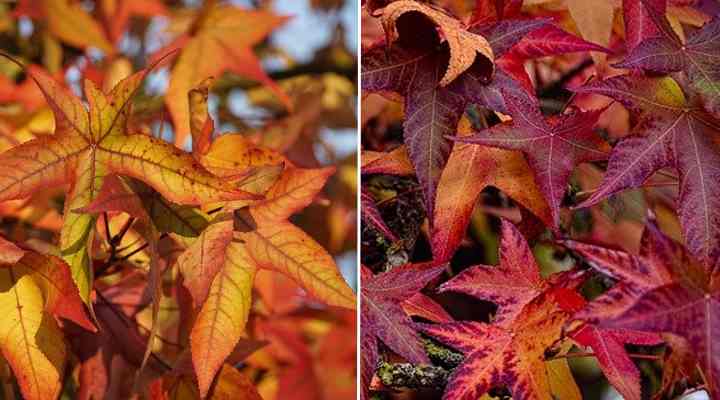
Sweetgum autumn foliage
Another feature of sweetgum leaves is their pleasant aroma when crushed. The leaves have a fresh, citrusy scent with sweet overtones.
One way to identify sweetgum trees in a landscape is by their leaves in the fall. Typically, sweetgum trees are the last of the deciduous trees to drop their leaves. The tree’s spectacular foliage fall colors set sweetgums apart from other deciduous trees. Also, in spring, sweetgum trees are usually the last of the deciduous trees to produce leaves.
Sweetgum Tree Bark
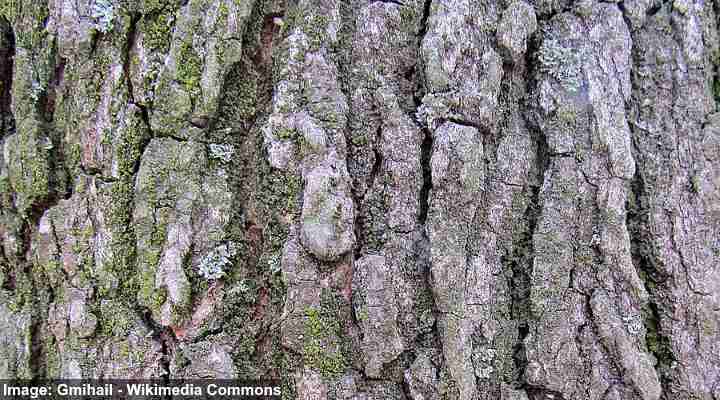
American sweetgum (Liquidambar styraciflua) bark
Sweetgum tree has light gray bark with vertical, irregular ridges covering a tall, straight trunk. As the tree matures, sweetgum bark becomes gray-brown, with deeper furrows and narrow ridges.
Sweetgum Tree Balls
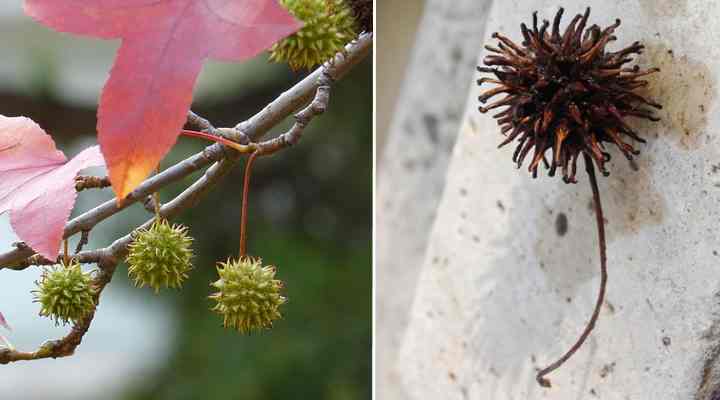
Sweetgum tree balls (gumballs) are green when immature (left) and dark brown when mature (right)
Sweetgum trees are known for their balls, also called gumballs, sweetgum fruits, or capsules. The spiky gumballs hang in clusters. The hard, brown, woody sweetgum balls measure between 1” and 3” (2.5 – 7.5 cm) and contain numerous seeds. For some gardeners, the sweetgum balls can cause a litter problem, making the tree somewhat messy when the balls fall between December and April.
Not all species of sweetgum trees have balls. Some fruitless varieties of sweetgum trees, such as the sweetgum ‘Rotundiloba,’ don’t produce the seedpods. This means that there is no mess from these sweetgums and their flowers rarely mature into spiky gumballs.
Sweetgum Tree Flower
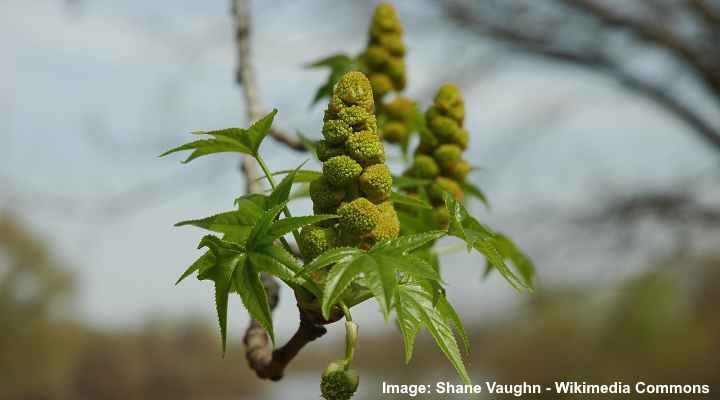
American sweetgum flowers
Sweetgum tree flowers are small inconspicuous clusters of yellowish-green flowers. Sweetgums bloom in April and May, but their non-showy flowers don’t add to the tree’s appeal.
Sweetgum Tree Identification
Sweetgum tree identification is by its bark, leaves, and fruit. To identify sweet gum trees, look for large star-shaped lobed green leaves that turn spectacular autumn red, yellow, and orange colors. Sweetgum tree bark looks light gray with vertical fissured ridges. Spiky gumballs are another identifying feature of sweetgum trees.
It can be challenging to tell sweetgum trees apart from some maple tree varieties. The main differences between the two species are that sweetgum leaves usually have deeper lobbing and are arranged alternately on branches, whereas maple tree leaves have an opposite leaf arrangement.
Types of Sweetgum Trees (With Pictures)
Let’s look in more detail at common varieties of sweetgum trees. You will find descriptions of the tree’s leaves, bark, growth habit, and spiky gumballs for each tree variety.
American Sweetgum Tree (Liquidambar styraciflua)
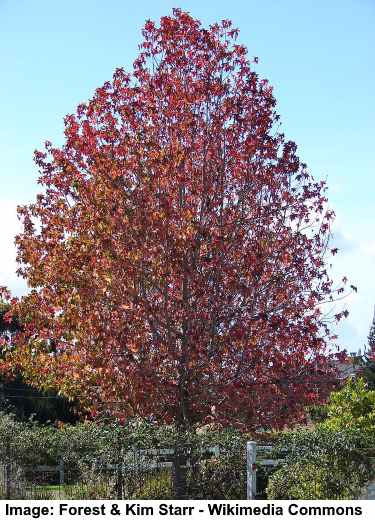
American sweetgum tree (Liquidambar styraciflua)
The American sweetgum tree (Liquidambar styraciflua) has large, star-shaped leaves and dark brown spiky gumballs. As a majestic shade tree, the American sweetgum has a tall, straight trunk with a broadly conical crown. This low-maintenance landscape tree grows between 60 and 80 ft. (18 – 24 m) tall and up to 60 ft. (12 m wide).
The American sweetgum’s notable characteristics are the glossy dark green, aromatic leaves, and globular spiny gumballs. In autumn landscapes, the American sweetgum is a spectacular tree with bright red, orange, yellow, or purple foliage.
The American sweetgum tree thrives in USDA growing zones 5 – 9. The tall, deciduous tree grows best in full sun. As an easy-care decorative tree, it grows well in most soil types and doesn’t mind growing in soggy soil.
Apart from American sweetgum, Liquidambar styraciflua is also known as red gum, star-leaved gum, American storax, hazel pine, copalm balsam, satin walnut, and alligatorwood. The common names refer to the tree’s two identifying characteristics—the sweet-smelling sticky resin and the color or shape of the leaves.
There are few considerations before planting a sweetgum tree in a backyard. The roots of sweetgum tree are relatively shallow. Therefore, it’s a good idea to keep the tree at least 10 ft. (3 m) away from buildings or sidewalks. Also, the sweetgum tree drops spiky balls in late winter or early spring. The hard nut-like sweetgum fruits can be a slip hazard if someone steps on them. Then, there is the mess to clear up after the leaves have fallen in the fall and seed capsules in winter.
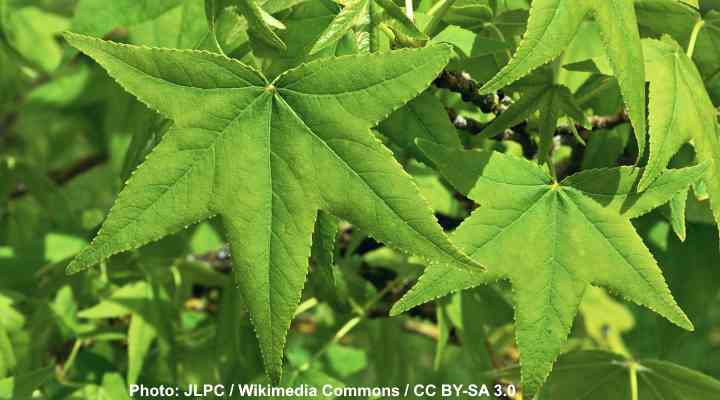
American Sweetgum leaves
Sweetgum tree leaves: American sweetgum leaves are five-pointed star-shaped blades that look like maple leaves. The palmately lobed, lustrous leaves have pointed leaflets with serrated edges. The fragrant leaves grow between 3” and 6” (7.5 – 15 cm) long and wide. The spectacular feature of sweetgum tree leaves is the brilliant fall color variations of reds, purples, oranges, and yellows.
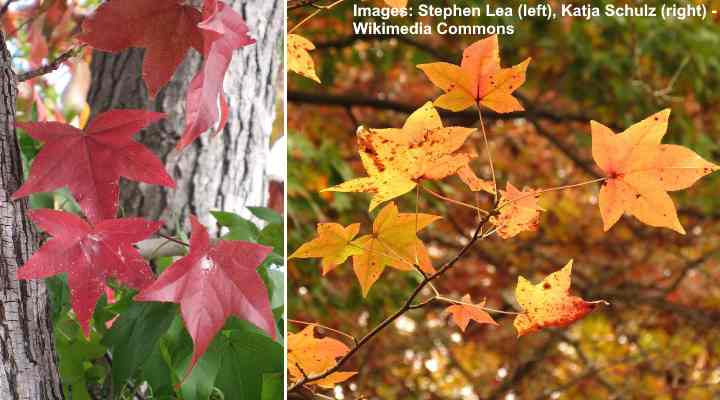
American sweetgum autumn foliage
Sweetgum tree balls: Gum tree balls on the American sweetgum are coppery-brown rounded spiky capsules. The sweetgum tree balls grow between 1” and 3” (2.5 – 7.5 cm) in diameter. The clusters of bristly tree balls persist on the tree until mid-winter or early spring. Cleaning up gumballs can be a problem in residential areas.
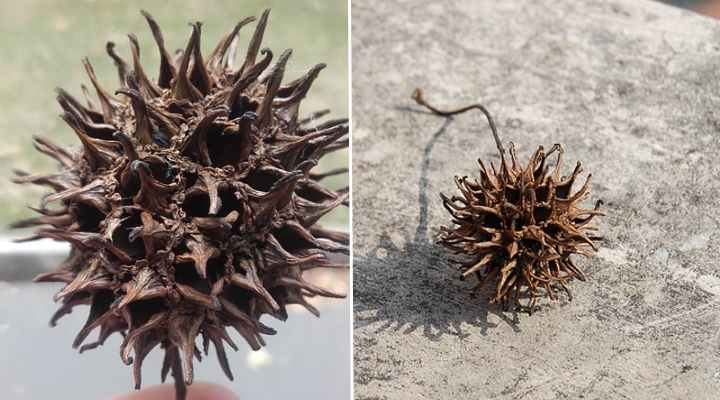
American sweetgum balls
Sweetgum ‘Slender Silhouette’ (Liquidambar styraciflua ‘Slender Silhouette’)
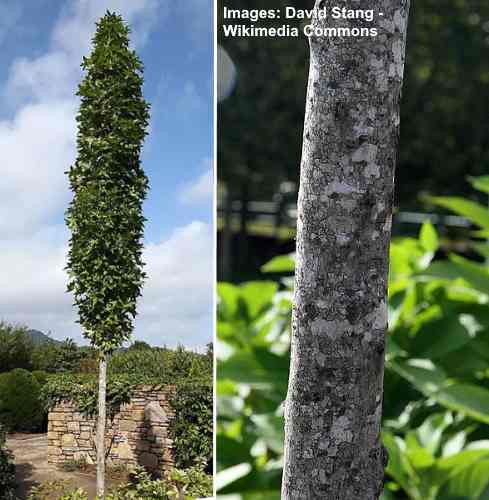
Sweetgum ‘Slender Silhouette’ (Liquidambar styraciflua ‘Slender Silhouette’) tree and bark
The sweetgum ‘Slender Silhouette’ is an elegant columnar tree that provides a vertical accent in small, compact landscapes. This tall skinny tree is a Liquidambar styraciflua cultivar with star-shaped, light glossy green leaves and spiky gumballs. The fast-growing fastigiate (columnar) tree matures at 50 ft. tall (15 m) and is only 4 ft. (1.2 m) wide.
Similar to the specimen tree, the ‘Slender Silhouette’ American sweetgum has inconspicuous white spring flowers. The shiny green lobed leaves also turn beautiful red and orange colors in the fall. Although this narrow sweetgum tree has spiky gumballs, they tend not to make a mess as they fall close to the slender tree.
The ‘Slender Silhouette’ sweetgum tree thrives in USDA zones 5 – 8. The deciduous ornamental tree grows fast in full sun and tolerates a range of soil conditions. You can grow the ‘Slender Silhouette’ as a specimen tree, a tall narrow tree for a vertical accent, or tall privacy screen planting.
Sweetgum tree leaves: The leaves on the American sweetgum ‘Slender Silhouette’ are five-pointed, lobed leaves in a star shape. The dark green foliage grows densely on upward-growing branches that give the tree its characteristic pencil-like growth habit.
Fruitless Sweetgum (Liquidambar styraciflua ‘Rotundiloba’)
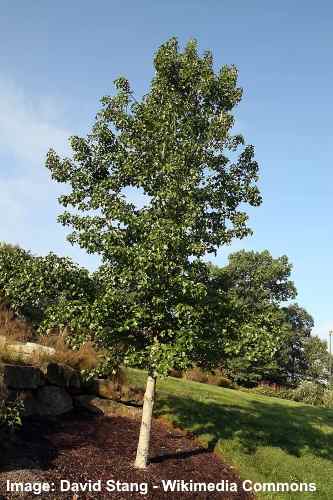
Fruitless sweetgum young tree (Liquidambar styraciflua ‘Rotundiloba’)
The American sweetgum ‘Rotundiloba’ tree doesn’t have spiky balls typical of most gumball trees. The sweetgum tree has characteristic dark gray-brown furrowed bark and star-shaped palmate leaves. The sterile ‘Rotundiloba’ is a pod-less sweetgum variety that won’t make a mess in the fall and winter.
The fruitless Liquidambar styraciflua ‘Rotundiloba’ grows best in USDA zones 6 – 9. The tall, low-maintenance shade tree has a narrowly pyramidal growth and grows between 60 and 70 ft. (18 – 21 m) tall. Because the sweetgum doesn’t have balls, it’s suitable for growing in most large garden landscapes. This specimen tree is ideal as a lawn or shade tree.
A distinguishing feature of the ‘Rotundiloba’ sweetgum is the round-tipped leaflets making up the palmate leaves. The cultivar’s name refers to the distinct rounded lobes that help identify this plant.

Fruitless sweetgum leaves and bark
Sweetgum tree leaves: Sterile American sweetgum ‘Rotundiloba’ leaves are glossy green and 6” (15 cm) long with five lobes. Unlike most other sweetgum tree leaves, the ‘Rotundiloba’ has rounded rather than pointed leaves. In the fall, the attractive leaves turn to shades of yellow and red.
Sweetgum ‘Worplesdon’ (Liquidambar styraciflua ‘Worplesdon’)
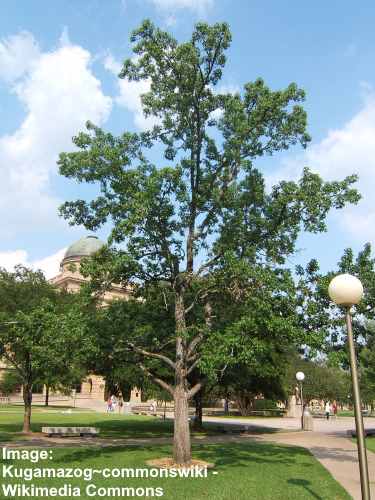
Sweetgum ‘Worplesdon’ tree (Liquidambar styraciflua ‘Worplesdon’)
The spectacular ‘Worplesdon’ American sweetgum cultivar has star-shaped leaves, spiked gumballs, and excellent fall color. This beautiful deciduous tree has a broadly pyramidal crown making it a stunning shade tree. Smaller than other sweetgums, the ‘Worplesdon’ tree grows between 30 and 50 ft. (10 – 15 m) tall and 40 ft. (12 m) wide.
The beautiful characteristic of the sweetgum ‘Worplesdon’ is the fiery red leaf color in the fall. This eye-catching red or burgundy foliage rivals some of the most popular Japanese maples.
The attractive green summer foliage, red and orange autumn leaves, and elegant branching give this sweetgum all-year visual appeal. You can grow this alluring decorative landscape tree in USDA zones 5 – 9. As with all varieties of sweetgum, grow the ‘Worplesdon’ in full sun and well-draining soil.
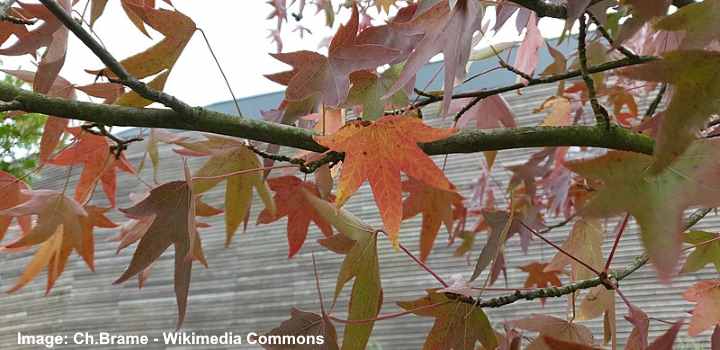
Sweetgum ‘Worplesdon’ leaves
Sweetgum tree leaves: The sweetgum ‘Worplesdon’ has deeply lobed, star-shaped glossy green leaves. These lustrous pointed leaves turn stunning shades of reds, oranges, and yellows in the fall.
Sweetgum ‘Variegata’ (Liquidambar styraciflua ‘Variegata’)
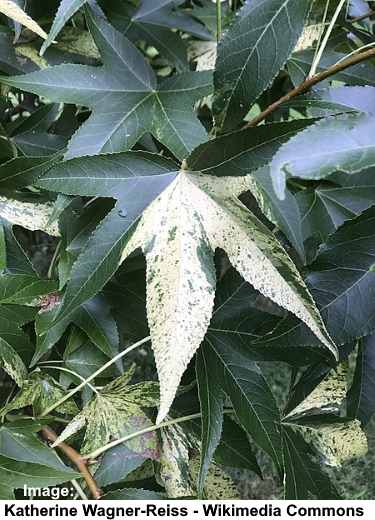
Sweetgum ‘Variegata’ leaves (Liquidambar styraciflua ‘Variegata’)
The sweetgum ‘Variegata’ is an unusual type of tree due to its variegated creamy-yellow and green star-shaped leaves. As a medium-sized, bushy tree, the sweetgum ‘Variegata’ is suitable for sunny gardens. This sweetgum variety takes 50 years to reach its mature height of 40 ft. (12 m) and a spread up to 26 ft. (8 m).
Sweetgum ‘Variegata’ leaves are large, deeply lobed creamy-yellow and green leaves that turn purple, red, or yellow in the fall.
Sweetgum ‘Lane Roberts’ (Liquidambar styraciflua ‘Lane Roberts’)
The sweetgum ‘Lane Roberts’ is an elegant deciduous landscaping tree suitable for small to medium-sized landscapes. The American sweetgum cultivar has star-shaped leaves, small clusters of non-showy flowers, and spiky balls. The attractive feature of the ‘Lane Roberts’ sweetgum is the crimson, nearly black color of the leaves in the fall.
Oriental Sweetgum (Liquidambar orientalis)
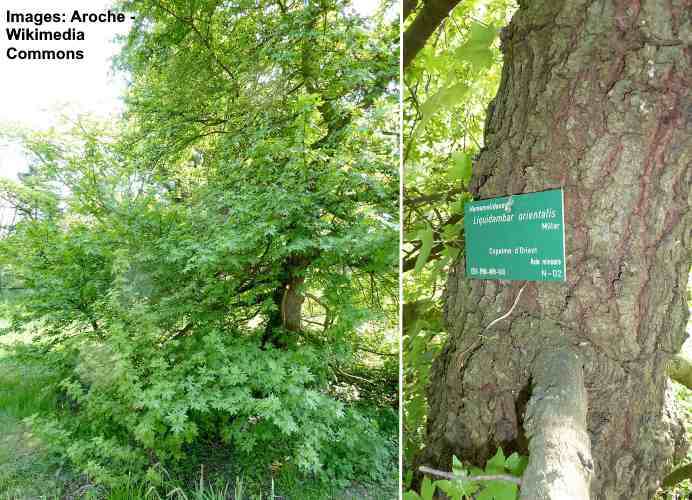
Oriental sweetgum (Liquidambar orientalis) tree and bark
Also called the Turkish sweetgum, this slow-growing small tree has small lobed leaves with coarsely serrated edges. The unusual tree leaves have double lobbing, making them unique in the Liquidambar genus. The Oriental sweet gum thrives in USDA zones 7 – 9 and grows between 20 and 30 ft. (6 – 10 m) tall.
The Oriental sweetgum can grow as a small ornamental tree or large shrub for sunny landscapes. The messy fruit can cause problems when the balls drop in winter, so it’s not practical for planting near sidewalks. Also, the shallow root system can damage buildings and pathways.
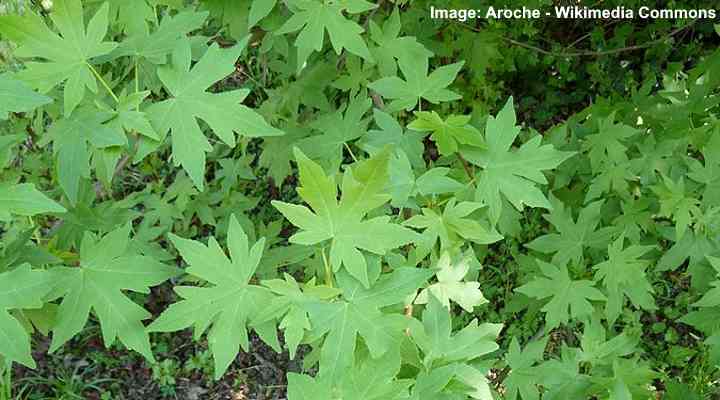
Oriental sweetgum leaves
Oriental sweetgum leaves are the smallest among the sweetgum varieties. The double-lobed light green leaves measure up to 3” (7.5 cm) across. In the fall, the leaves turn shades red and yellow.
Chinese Sweetgum (Liquidambar formosana)
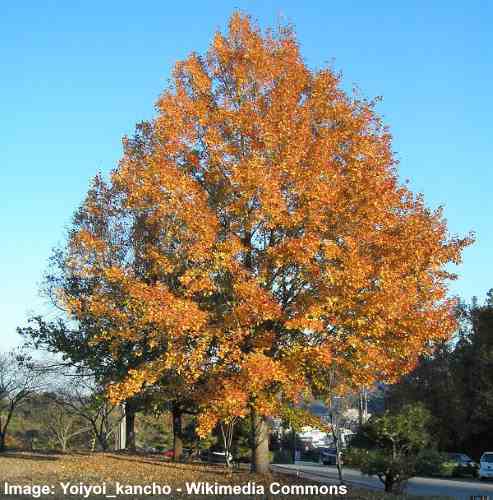
Chinese sweetgum tree (Liquidambar formosana)
The Chinese sweetgum is a large shade tree with spiky gumballs, large 3-lobed leaves, and a pyramidal crown that becomes oval-rounded with age. Also called Twainese sweet gum or Formosan gum, this Liquidambar species grows between 100 and 131 ft. (30 – 40 m) tall. Not as cold-hardy as other sweetgums, the Chinese sweetgum grows in USDA zones 7 – 9.
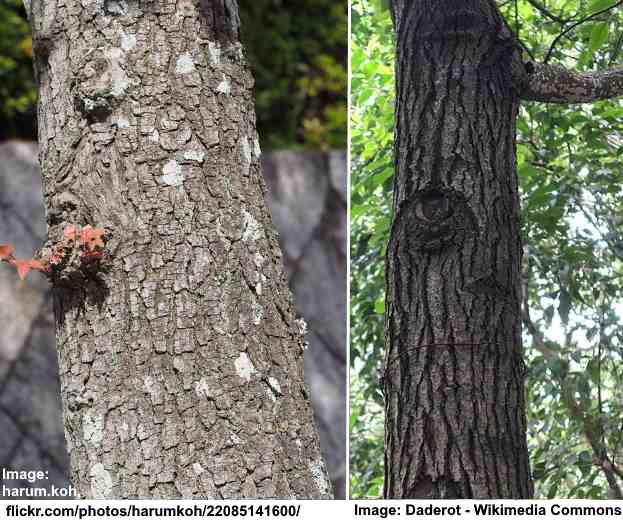
Chinese sweetgum bark
The identifying feature of the Chinese sweetgum is the large leaves. The Chinese sweetgum leaves have three lobes, unlike the typical five to seven of other species. The middle lobe is a pronounced triangular shape. Chinese sweetgum leaves measure between 3” and 6” (7.5 – 15 cm) across.
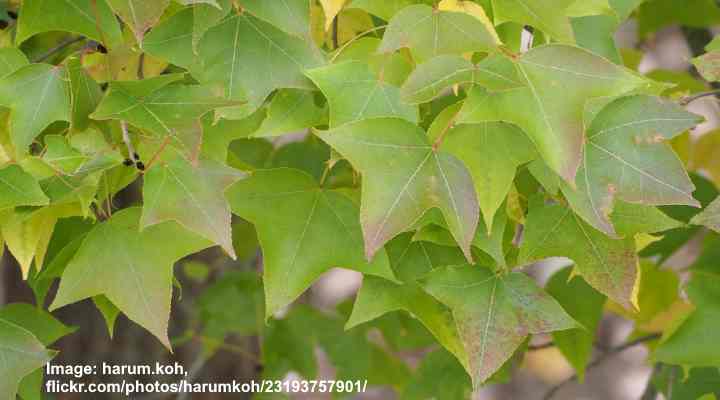
Chinese sweetgum leaves
As with most types of sweetgums that produce spiky balls, the Chinese sweetgum fruit can be a litter problem in the fall. Also, the shallow rooting system can cause damage to buildings.
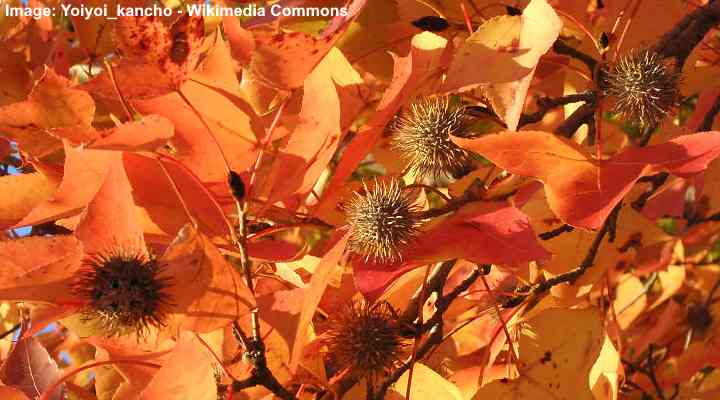
Chinese sweetgum seeds and autumn foliage
Chang’s Sweetgum (Liquidambar acalycina)
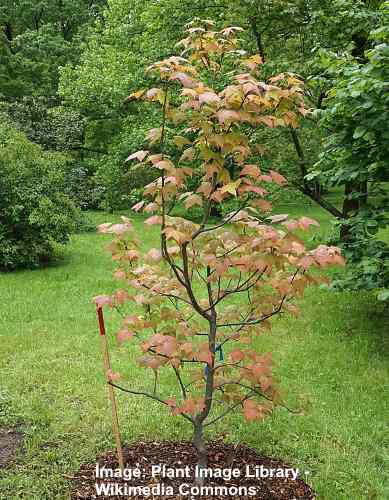
Chang’s sweetgum (Liquidambar acalycina) young tree
Native to Asia, Chang’s sweetgum tree is a small tree that grows between 30 and 50 ft. (10 – 15 m) tall. The Chang’s sweetgum is identified by its rounded, pyramidal canopy, three-lobed broadleaves, and small, hard brown gumballs. This sweetgum variety grows best in sunny landscapes in USDA zones 6 – 9.
Chang’s sweetgum leaves look like maple tree leaves and measure between 3” and 6” (7.5 – 15 cm) across. Each leaf blade has three lobes, with a broad, triangular lobe in the center. The deep green leaves turn bright red to purple in the fall.
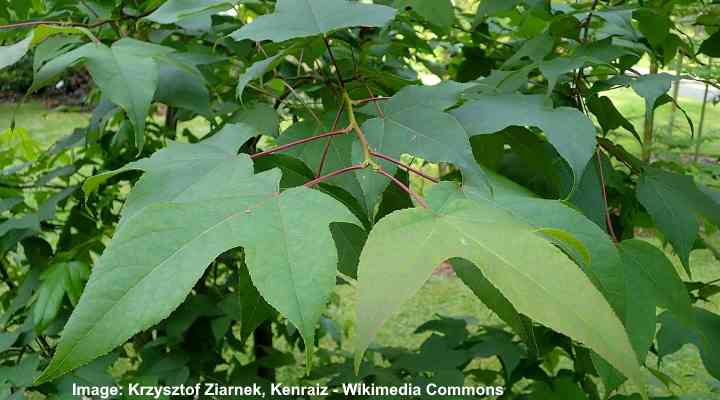
Chang’s Sweetgum leaves
The balls that drop from Chang’s sweetgum tree are less of a risk to those from the American sweetgum. The gumballs are less ridged, and there is less chance of slipping on the round, hard nuts.
Sweetgum ‘Gumball’ (Liquidambar styraciflua ‘Gumball’)
The American sweetgum cultivar ‘Gumball’ is a dwarf tree with a rounded growth habit. The beautiful landscaping tree grows up to 6 ft. (1.8 m) high and wide. In fall, the globular-shaped tree turns from deep green to spectacular purple-red colors.
Related articles:
